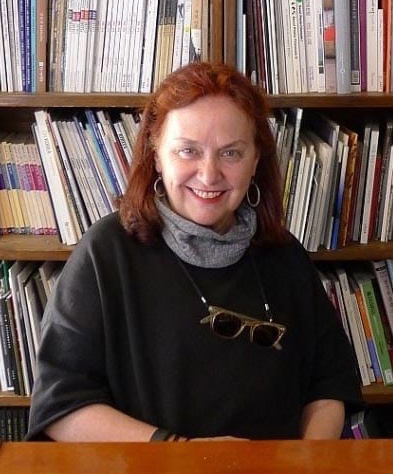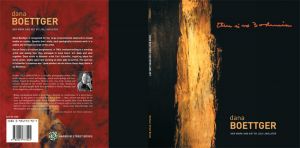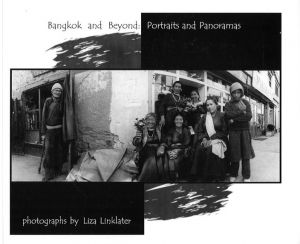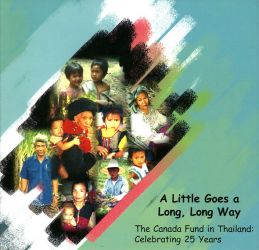Liza Linklater
Photographer • Writer

Liza Linklater is a Canadian photographer and writer, with a particular interest in travel and documentary projects. She holds degrees in social anthropology/photography (M.A. thesis on visual anthropology) and in journalism. She has lived in Asia over a period of 15 years. Her photographs have been exhibited in Canada, Thailand, the Philippines and South Korea (13 solo and 22 group shows). Her articles and photographs have been published in North American and Asian magazines and newspapers.
“Liza has also worked on the staff of magazines, and in communications positions for the government of Canada.”
Government Reports, magazine & newsletters
- Canadian International Development Agency
- Citizenship and Immigration Canada
- Foreign Affairs Canada
- Industry Canada
- National Gallery of Canada
Public Relations Work
- Amnesty International
- Canadian Advisory Council on the Status of Women, City of Toronto
- Indian and Northern Affairs Canada, Dr. Daniel Hill (Ontario Ombudsman) for The Freedom-seekers: Blacks in Early Canada (The Book Society of Canada Ltd.)
- Greek National Tourist Organization
- L’Hexagon Publishers in Montreal (book cover photo for Lettres du Siam)
- Methuen Publishers, Ms. Emma (fashion ads)
- National Film Board/Phototheque, MATCH International
- Ontario Black History Society, Tourist Office of Spain
Selected Publications (writing and/or photography)
in asia
- Asia Magazine
- Asiaweek
- Bangkok Post
- Far Eastern Economic Review
- Far East Traveller
- Living (Singapore)
- Living in Thailand
- Look East
- Metro : Magazine
- Photoworld (Australia)
- Sawaddi
- Sawasdee (Thai International's Inflight Magazine)
- Town & Country (Manila, Philippines edition)
- Treasures (Asian Spirit’s Inflight Magazine).
in north america
- Bout de Papier
- Camera Canada
- The Canadians - George Woodcock (Fitzhenry and Whiteside Publishers)
- Darkroom Photography (USA)
- Eaton's and Sears catalogues
- Every Woman's Almanac
- Flare
- Forever Young
- Frontiers (Telecom Canada)
- Globe and Mail
- IDRC Reports
- NOW
- Ontario Craft
- Ontario Times
- Ottawa Business Life
- Ottawa Citizen
- Ottawa Magazine
- Ottawa Woman
- Our World
- Photo Canada
- Photo Life
- Quill 'n' Quire
- Southam News Service
- The Financial Post
- Today's Seniors
- Toronto Star
Published Books and Postcards

There is no Bohemia – Dana Boettger: Her Work and Art
ISBN: 0-921773-92-7
Bangkok and Beyond: Portraits and Panoramas
ISBN: 974-91129-5-4 (2003)
64 pages (photos) (Available for purchase — Book – $20, and a Set of 14 Postcards (5″x7″) – $14 — Contact me for details)


A Little Goes a Long, Long Way — The Canada Fund in Thailand: Celebrating 25 Years
ISBN: 974-88587-3-1 (2001)
72 pages
Philippine Portraits Postcard Sets
Available for purchase.
A collection of 24 postcards. Each card measures 5″x7″ and is printed on foldcote 15 paper and presented in a tri-fold glossy black foldcote package.
$20 per set.
Contact me for details.

An Article about Liza by the Philippine Star
Liza’s People
YELLOW LIGHT By Tara F.T. Sering (The Philippine Star) Updated September 05, 2011
The past few months have been prime-time for collective soul-searching, a kind of mid-year national self-check that, like health checks, we know ought to be done but often put off for another time. Luckily, there are those who insist on doing it for us on a regular basis, however subtle they are in their ways — among them, artists, academics, writers and photographers both local and foreign.
And while there’s no shortage of works by local talent that reflect, and reflect back to us, who we are collectively, looking for clues through the lens of outsiders offers another perspective. In February this year, at the Ayala Museum, Pulitzer Prize-winning photojournalist Kim Komenich exhibited almost a hundred photographs, all taken while on assignment for the San Francisco Examiner in 1986 during the People Power Revolution, otherwise known as EDSA I. The exhibit swung the spotlight back to a shining moment in fairly recent history when we managed to somehow keep calm in the thick of extraordinary circumstances. No shots fired, no bloody mess; nice job, guys.
An earlier, much quieter but equally engaging exhibition was Liza Linklater’s “Philippine Portraits” at The Alcove, a gallery devoted exclusively to photography, at the Filipinas Heritage Library, a cozy but impressive repository of historical documents on the Philippines.
“Philippine Portraits,” held in November last year, displayed 15 uniquely striking images of ordinary Filipinos living out their everyday realities under various circumstances. Students, tricycle drivers, boxing trainers, security guards, traffic policemen, cigarette vendors, young mothers — photographed in black and white, with the original skin tone meticulously reapplied — all of them held for a moment from their daily activities and captured in images that present the quiet dignity so often overlooked in ordinary, everyday life.
For Liza, who has lived in several countries, embedding herself in the culture and nuanced routines of each one, the real character of the Philippines shines forth through its people. And the collection she chose to exhibit, in her words, “is about the people you meet every day, doing what they do every day. They add to the charm.”
Looking at her photographs, the charm, it appears, is a visual narrative that adds, as only a photographer with genuine interest in people can, even more layers to the complex story of who we are.
People Person
I met Liza in April, through a common friend quite by accident (they were having coffee in the park, and I was brisk-walking past from one errand to another), during which I learned that, after four years of living in the Philippines with husband James Trottier, counselor for political and economic relations of the Canadian Embassy in Manila, the two of them would soon be heading home.
Home is Canada, where she was born, and where her interest in both people and photography took root at an early age. She was 10 years old when she started taking photos during family trips and, like a resourceful people person, getting friends to model for her. Her life, it seems, progressed consistently with her interests — in high school she was the yearbook photographer, after which she studied photography for a year. She then worked as a stylist for a studio in Toronto, a stint that took her on trips to places such as Barbados and Portugal, and that inspired yet another of her lifelong passions: travel.
It was in college that she was able to fully consolidate all these interests by taking a course in anthropology, specializing in Southeast Asia, particularly in Thailand’s ethnic groups (this was eventually followed by a master’s degree in social anthropology and photography, a mash-up of sorts that she designed for herself because a single course that focused on both was unavailable in Canada at the time).
“Little did I know that I would end up there,” she says of Thailand. Her husband’s first foreign posting as a member of the Canadian diplomatic corps was in Thailand. It was also his first of two postings in the country. Liza and her husband have lived in Asia, including the Philippines, for a total of about 13 years.
In Thailand Liza traveled extensively, working as a photographer in tandem with a journalist, for various magazines as well as for The Canadian International Development Agency (CIDA), before eventually going at it alone as both writer and lens woman.
Anyone who remembers the pre-digital age will understand just how cumbersome photographic equipment had been. You moved at a snail’s pace, the weight of the world draped on your shoulders, and you worried about everything and its cousins — the quality of your shots, whether or not you had carried along enough rolls of film, whether they would survive the airport X-ray machines, whether or not you might be able to convince security to spare your rolls from the X-ray machines, then developing them in your own darkroom. This difficulty was also part of the romance of the process, and this was how one earned his or her stripes as a photographer, a kind of test of true love. “I would be lugging around several bulky cameras at airports and all over the place,” Liza recalls. “They weighed a ton. I don’t know how I did it.”
Portraits of Pinoys
The other part of the process is the actual taking of the photographs. Photography has since been revolutionized as technology managed to shrink the size of cameras considerably, and while it’s easy enough for us to look at people, things or scenes, and maybe take photos for posterity, a photographer with an intelligently probing eye sees a whole story, and a well-trained one will gaze at its subject with genuine interest and real empathy. The process becomes some kind of conversation, satisfying on both sides.
For “Philippine Portraits,” a project that was several months in the making, Liza chose subjects she encountered every day, asked them to pose for photos at the place where she’d met them, and then revisited them with colored printed copies for them to keep as souvenirs.
“Some people were easy enough to find again,” she says. “But others, like the construction workers, because of the nature of their jobs, were difficult to track. And then there were others I never saw again.”
What was common to all was the fact that they were all ready and willing to take a break from what they were doing — no matter how difficult, like the young mother who pedals a passenger sidecar around Intramuros for a living, or the boxing trainers clutching dreams of Manny Pacquaio -like glory in their fists, or the cops managing the heat and grime of our infamous metropolitan traffic — and grant her request.
Ultimately, Liza Linklater’s Philippine Portraits is about people who try, and who do it with a smile, and it’s gratifying to be seen, and to see ourselves, in this way.
To view more of Liza Linklater’s works, head over to the gallery page.
https://www.philstar.com/lifestyle/arts-and-culture/2011/09/05/723414/lizas-people
2020 © Liza Linklater. All Rights Reserved. Site by EICA Atelier.